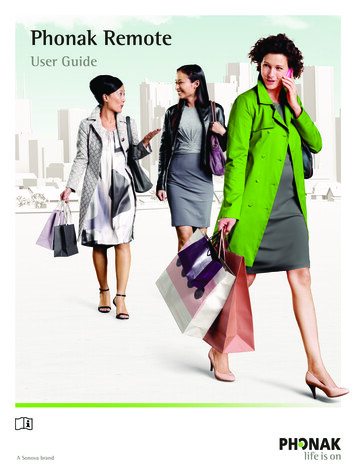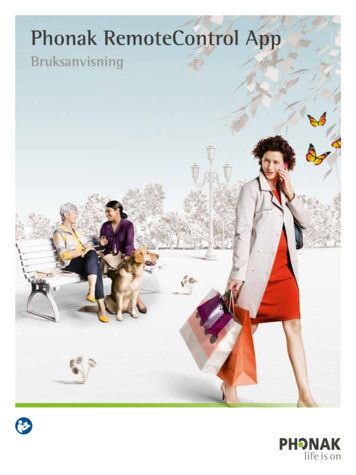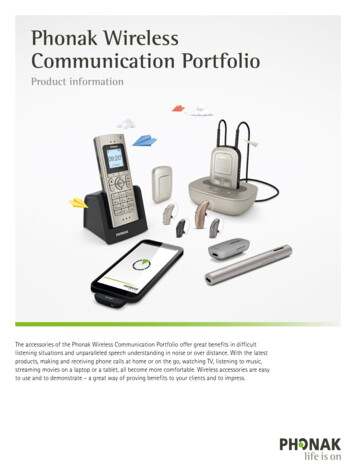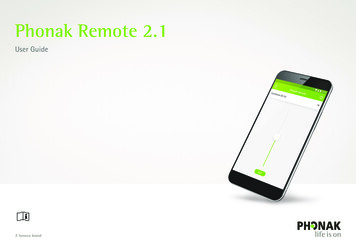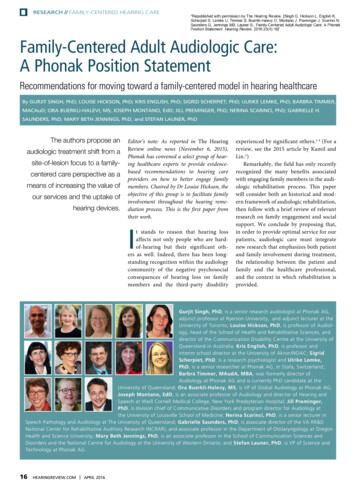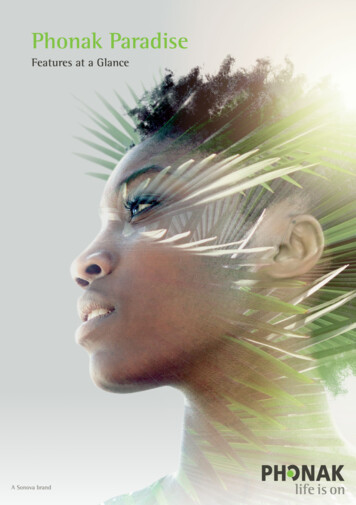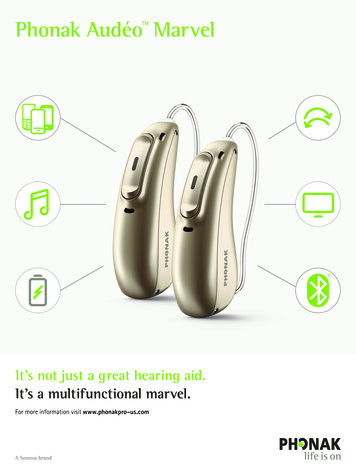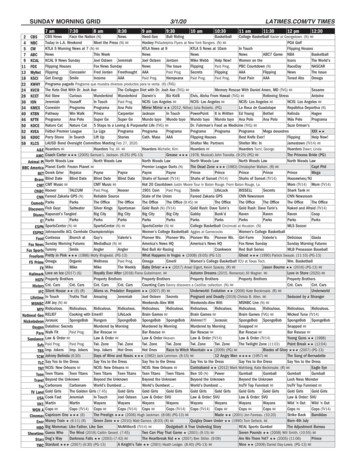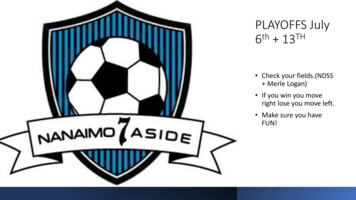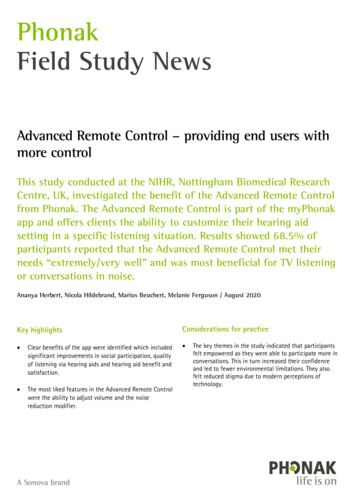
Transcription
PhonakField Study NewsAdvanced Remote Control – providing end users withmore controlThis study conducted at the NIHR, Nottingham Biomedical ResearchCentre, UK, investigated the benefit of the Advanced Remote Controlfrom Phonak. The Advanced Remote Control is part of the myPhonakapp and offers clients the ability to customize their hearing aidsetting in a specific listening situation. Results showed 68.5% ofparticipants reported that the Advanced Remote Control met theirneeds “extremely/very well” and was most beneficial for TV listeningor conversations in noise.Ananya Herbert, Nicola Hildebrand, Marius Beuchert, Melanie Ferguson / August 2020Key highlightsConsiderations for practice Clear benefits of the app were identified which includedsignificant improvements in social participation, qualityof listening via hearing aids and hearing aid benefit andsatisfaction. The most liked features in the Advanced Remote Controlwere the ability to adjust volume and the noisereduction modifier.The key themes in the study indicated that participantsfelt empowered as they were able to participate more inconversations. This in turn increased their confidenceand led to fewer environmental limitations. They alsofelt reduced stigma due to modern perceptions oftechnology.
IntroductionA trend has emerged in the last decade that shows peopleare becoming more health conscious and want to be moreinvolved in their healthcare decisions (Jokstad et al., 2018).As a result, services that focus on “healthy aging” havebecome one of the fastest growing sectors in healthcare.Healthcare is now benefiting from technology, not only toimprove the quality of care provided but also the way it isdelivered by healthcare professionals. The term eHealth hasbeen coined to represent the use of information andcommunication technologies for healthcare. eHealth has inthe last few years grown due to the digital evolution of thehealthcare industry and increased uptake in digitaltechnology (Paglialonga et al., 2018).A subsection of eHealth is mHealth which refers to thepractice of medicine and public health supported by mobiledevices. People of all ages are embracing digital technology,especially smartphones. It is estimated that there are 2.71billion smartphone users worldwide which is approximatelya third of the world’s population. Interestingly, there is astrong growth in smartphone ownership among the 55 agegroup in 2019 compared to 2015 (Pew Research Center,2019).Technologies such as smartphone-connected hearing aidshave created more of a client-centered delivery model ofhearing healthcare. Smartphone-connected hearing aidsallow clients to adjust how their hearing aids sound in realtime using an app, therefore clients can feel empowered asthey can better meet their daily listening needs andpreferences. This enables users to feel more independent andto be more involved in their hearing healthcare, which canimprove hearing and communication outcomes (Maidment& Ferguson, 2018; Maidment et al., 2019).This study conducted in 2019 looked at the performance ofa new function within the myPhonak app, the AdvancedRemote Control. The app connects to Phonak hearing aidsand allows clients to choose their hearing aid setting andcustomize their hearing experience in a specific listeningsituation. These changes are then saved on the app and canbe accessed anytime.The Advanced Remote Control has three preset listeningscenes called ‘scenarios,’ which are based on programs fromPhonak Target. These are Restaurant (based on speech-innoise program), Music (based on acoustic music program)and TV (based on calm-situation program). Within thescenarios and programs, different sound modifiers (i.e.hearing aid settings or features) can be adjusted in realtime, such as the bass and treble weighting, the strength ofthe noise canceller, and the beamformer. Additionally,within each scenario there are two sound modifier presets,which allows the client to quickly toggle betweenpredefined settings.The objectives of this study:1. To assess the benefits and use of the ‘scenarios’ andsound modifier presets of the Advanced RemoteControl.2. To explore and identify the users’ preferences andusability of the Advanced Remote Control.3. To explore whether the direct input and choice that thepatients have over the programming for their hearingaids influence their view of the hearing aid fittingprocess.MethodologyParticipantsA total of 41 (29 male, 12 female) out of the 42 recruitedparticipants completed the study. All participants were fromNottingham Audiology Services, Nottingham UniversityHospitals NHS Trust. The average age was 68.8 years, withthe youngest participant being 39 years old and the oldestparticipant being 82 years old. Thirty participants wereexperienced hearing aid users and 11 participants were newusers. All participants had a sensorineural bilateral hearingloss in the range of mild to moderate for low frequenciesand mild to moderately severe for the high frequencies. Allparticipants owned an Apple iPhone 5 or newer and usedtheir phone for functions more than just sending andreceiving calls / text messages.Figure 1. Four standard hearing losses N2–N5EquipmentPhonak Audeo B90-Direct receiver-in-the-canal hearing aidswith xP receivers and audiologically appropriate acousticcoupling (cShells, closed or open domes were used).For the purpose of the study, the Advanced Remote Controlwas created as a separate app. This app connects to thePhonak Field Study News Advanced Remote Control – providing end users with more control2
hearing aid via Bluetooth , and enables hearing aid users toadjust their hearing aids via their smartphones.Proceduresthat explores listening effort and fatigue and comprises 40items with a 5-point response scale. For both first-time andexisting hearing aid users, scores for overall, cognitive,physical, emotional, and social significantly decreased fromappointment 1 to 3.The study was a single-center, prospective, observationaldesign which used mixed methods and involved two phases.The first phase lasting seven weeks looked at the usabilityand benefits of the Advanced Remote Control. This phaseconsisted of three face-to-face study visits as well as homebased tasks. The second phase involved focus groups andexplored the usability and personal experiences of theparticipants.Phase one:Appointment oneThis involved completing various quantitative assessments.The participants were fitted with the study hearing aidsusing the ‘Adaptive Phonak Digital’ fitting formulae andAudiogramDirect was performed. The Advanced RemoteControl app was downloaded onto the participants phoneand in-depth demonstration was provided by the researchaudiologist. Participants were asked to familiarizethemselves with the app and the hearing aids prior to thenext appointment.Appointment twoFine-tuning of the hearing aids was performed if required.Participants were asked to complete further quantitativeassessments such as the Vanderbilt Fatigue Scale and wereinstructed on the study tasks they needed to complete athome before the third study visit. The study tasks involvedasking the participants about specific use of the appmodifiers in certain environments. Participants were alsorequired to complete two online feedback surveys beforetheir third study visit. During appointment two and three,participants were asked to complete the Bamford-KowalBench (BKB) Speech-in-Noise test.Appointment threeOverall feedback on the app and outcome measures such asquestionnaires and speech-in-noise testing were completed.Phase two:Two focus groups were held each with four participantsfrom phase one. The transcripts of the focus groups wereanalyzed.ResultsThe wearing time of the hearing aids throughout the studywas high (12.85 hours). One of the quantitative assessmentsthe participants had to complete was the Vanderbilt FatigueScale. This assessment is a subjective self-report measureFigure 2. Vanderbilt Fatigue Scale score as (A) appointment 1 before beingfitted with hearing aids, (B) appointment 3 with study hearing aids and appThe initial hearing aid preference questionnaire showed thatparticipants ranked highly the ability to optimize theirhearing aids themselves using smartphone technology.Participants reported that the app met their needs“extremely/very well” (68.5% of participants) or “somewhatwell” (26.3% of participants). In the last two weeks of thetrial, 55% of participants reported that they used the app 8 times or multiple times per day. With the BKB Speechin-Noise test, the scores for each app program tested atboth appointments were 95%.The best reported features were the ability to adjust thequality of sound (42.1%), which was reported to be the mostuseful feature when having a conversation in the presenceof background noise (50%) and when watching TV (31.6%).Participants liked volume (31.6%) and noise reduction(31.6%) modifiers. They reported that they least likedsoft/loud (23.7%) and sound focus (26.3%). Someparticipants reported they would like to have greaterautomation/personalization (13.2%) and be able to makemore situation-specific adjustments (13.2%).From the focus group, participants stated that they weremore likely to use the app when they thought the situationwarranted it. Participants found they used the AdvancedRemote Control in extreme situations, such as noisyrestaurants, pubs, and areas that had an echo. The majorityreported that they had sufficient skills to use the app as itwas simple to navigate. Participants noted the positiveperception of others regarding the app and the potential thishad to reduce the stigma surrounding hearing aids. For otherparticipants, the app helped their own acceptance of thehearing aids. Some participants commented on how the appalso benefited friends and family due to increasedparticipation in conversations and empowering family toplay a role in their hearing healthcare.Phonak Field Study News Advanced Remote Control – providing end users with more control3
Many participants commented on the feeling ofempowerment the app gave, providing them with a greatersense of control over their hearing loss which increased theirconfidence and led to fewer environmental limitations.However, participants also noted that having to choosebetween multiple settings or recall the name of theircustomized setting added cognitive burden. The highestnumber of adjustments using the app were conducted in thefirst three days. Participants reported a lot of exploration,adjustment and use in the beginning.The participants liked the noise reduction and volumemodifiers the most. The beamformer slider and soft/loudmodifier were liked the least. Participants rated the appmost useful in noisy environments and whilst watching TV.situations they increased the gain towards more clarity.Many participants reported they used the app in complexlistening environments. This suggests that when theparticipants felt the hearing aids were not sufficient for thecurrent listening situation they were in, they were able toadjust it themselves using the app.ConclusionOverall, the study identified many benefits of the AdvancedRemote Control in terms of social participation, hearing aiduse, satisfaction and quality of listening. The greatestbenefit for participants was the ability to control and adjustthe hearing aids themselves, especially whilst having aconversation in a noisy environment. Additional benefitsincluded reduced stigma and feeling more empowered andconfident.The app empowers clients to make adjustments to theirhearing aids without having to see their Hearing CareProfessional.In the study, some participants reported they would like tohave more personalization options and be able to makemore situational-specific adjustments. Since this study,further improvements have been made to the myPhonakapp. In the myPhonak 4.0 app, the Advanced Remote Controlnow has a new spatial noise canceller, Dynamic NoiseCancellation, available on the Speech Focus slider forPhonak Audéo Paradise (P90) devices. This feature isactivated in noisy situations and allows the end user toimprove the SNR by up to 4 dB; thus providing end userswith the option to customize their listening experienceeven more.Figure 2. Situations in which the app was rated most usefulDiscussionClear benefits of the app were identified from the focusgroup, which included reported improvements in socialparticipation, quality of listening via hearing aids andhearing aid benefit and satisfaction. As there was no controlgroup used in the study, it is possible that the improvementscould be due to the participants being fitted with newerhearing aids, the app, or a combination of both.A positive of using the app was the user adjustability ofhearing aid settings which led to increased participation ineveryday life for some participants and a perceived increasein speech performance in noisy situations. Noisecancellation was the most liked feature in the app, whereasthe beamformer slider was the least useful. A reason for thiscould be due to many participants having venting in theircShells or open domes. Results showed that participants didnot reduce the hearing aid gain and in difficult listeningThe Bluetooth word mark is a registered trademark owned by BluetoothSIG, Inc. and any use of such marks by Sonova AG is under license.IOS is a trademark of Cisco Technology, Inc.Android and Google are trademarks of Google LLC.iPhone is a trademark of Apple, Inc.Samsung is a trademark of SAMSUNG.ReferencesJokstad, K., Skovdahl, K., Landmark, B. & Haukelien, H.(2018). Community healthcare professionals’ experiencesof user-involvement in reablement. Health and Social Care,27, 907–916.Maidment, D.W. & Ferguson, M.A. (2018). An application ofthe UK Medical Research Council’s guidelines forevaluating complex interventions: a usability studyassessing smartphone-connected listening devices inPhonak Field Study News Advanced Remote Control – providing end users with more control4
adults with hearing loss. American Journal of Audiology,27, 474–481.Maidment, D.W., Ali, Y.H.K. & Ferguson, M.A. (2019).Applying the COM-B model to assess the usability ofsmartphone-connected listening devices in adults withhearing loss. Journal of the American Academy ofAudiology, Epub ahead of print, doi: 10.3766/jaaa.18061.Paglialonga, A., Nielsen, A.C., Ingo, E., Barr, C. & LaplanteLevesque, A. (2018). eHealth and the hearing aid adultpatient journey: a state-of-the-art review. BiomedicalEngineering Online, 17.Pew Research Center, February 2019, “SmartphoneOwnership Is Growing Rapidly Around the World, but NotAlways Equally”. Available otalways-equally/. Accessed 02.07.2020.and audiological measurement methods, and functiondevelopment in the field of eAudiology.Nicola HildebrandNicola Hildebrand is a trained hearingcare professional and studied medicaltechnology and hearing aid acoustics atthe University of Applied Sciences,Lübeck. As a validation audiologist, shejoined Phonak in 2004. From 2005 to2019, she developed and researched new innovative fittingand measurement methods as a member of the Science andTechnology department at Sonova. In 2019 NicolaHildebrand took over the leadership position of the Expert ofthe R&D Software Application Exploration Stream.AuthorAnanya HerbertInvestigatorsMelanie FergusonDr. Melanie Ferguson is the Head ofAudiological Science at the NationalAcoustic Laboratories, Sydney, whereshe joined in March 2019. She leads theAdult Hearing Loss research program,which focuses primarily on connectedhealth, service delivery models and outcome measures. Priorto that she was Associate Professor in Hearing Sciences andResearch Lead for the Mild to Moderate Hearing Lossprogram at the NIHR Nottingham Biomedical ResearchCentre, UK. She is actively involved in audiology professionalaffairs and has had leadership roles in the UK’s BSA andBAA.Ananya Herbert received her BSc(Hons) Audiology degree from theUniversity of Leeds, England, andworked as an adult audiologist in theNational Health Service (NHS) in theUK. She later went on to completeseveral pediatric masters modules at the University CollegeLondon (UCL) before specializing in pediatric audiology andworking at Great Ormond Street Hospital (GOSH) beforemoving to Switzerland to join Phonak as an AudiologyManager. Ananya now works closely with the PhonakeSolutions and eAudiology team.Dr. Melanie Ferguson would like to thank DavidMaidment, Rachel Gomez, and Alia Habib who were coinvestigators also involved in the study.Marius BeuchertMarius Beuchert received his BSc inHearing Acoustics from LübeckUniversity of Applied Science, and hisMSc in Audio Communication andTechnology from the TechnicalUniversity of Berlin. He joined Sonova asaudiological engineer in the Science and Technologydepartment in 2015. In 2019 he took over the position asProduct Owner of the R&D Audiology and FittingExploration. His work history includes research on fittingPhonak Field Study News Advanced Remote Control – providing end users with more controlV1.00/2021-03 2020 Sonova Canada All rights reservedAuthors and investigators5
Advanced Remote Control - providing end users with more control . This study conducted at the NIHR, Nottingham Biomedical Research Centre, UK, investigated the benefit of the Advanced Remote Control from Phonak. The Advanced Remote Control is part of the myPhonak app and offers clients the ability to customize their hearing aid
